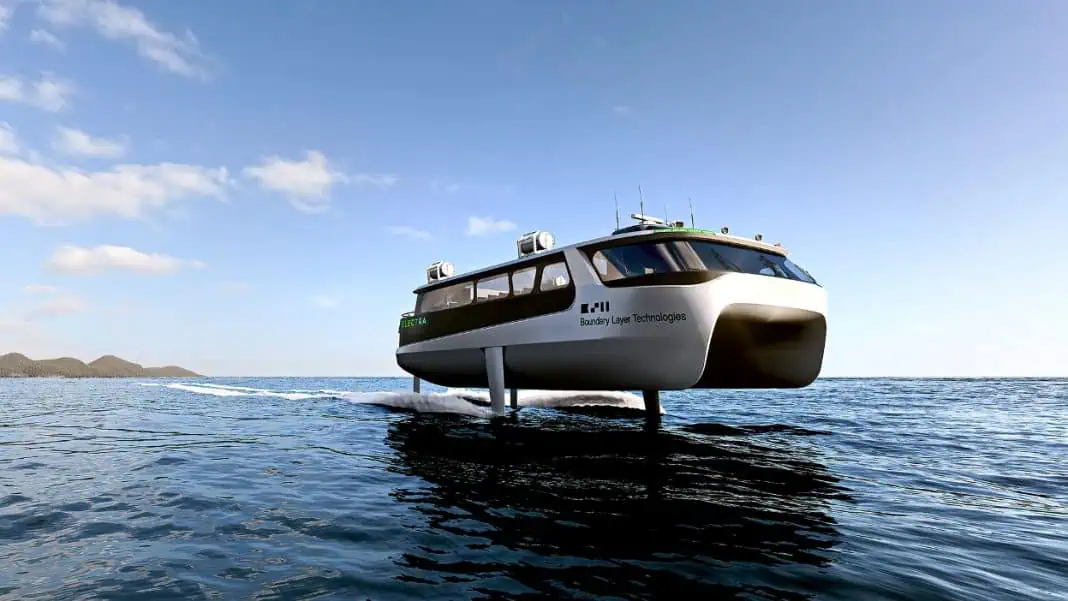Boundary Layer Technologies, a California-based marine technology startup has partnered with Danfoss’ Editron division and has signed a Letter of Intent for the supply the electrical drivetrain system required to power its hydrofoiling electric ferry, ELECTRA.
“Danfoss’ experience as a world leader and trusted partner for several electric ferry projects around the world will help us accelerate the delivery of ELECTRA.” says Ed Kearney, CEO of Boundary Layer Technologies. “We are incredibly excited to be embarking on this journey towards maritime decarbonisation together”
“The combination of Danfoss’ Editron division electrical drivetrain system and BLT’s hydrofoiling technology will enable a new class of electric ferries further driving decarbonization of the maritime industry”, according to Mike Shafar, Danfoss’ Editron division’s NAM Senior Sales Development Manager for Marine. “It’s an honor to be selected to partner with Boundary Layer Technologies on ELECTRA. An all-electric ferry utilizing hydrofoiling technology to increase propulsion efficiency and eliminate emissions is a harmonious blend of functionality and sustainability.”
ELECTRA will utilize the EDITRON Marine System, which is a complete DC based power plant and propulsion system specifically designed for marine vessels. This includes DC-distribution, electric power generation, energy storage utilization, propulsion and thruster drivetrains, and overall control and monitoring of the system. The system will be coupled with BLT’s proprietary podded z-drive propulsion system.
For ELECTRA, the lightweight EC-C1200-450 inverters will be utilized for propulsion and DC-DC conversion, along with AC inversion for hotel loads, being supplied by ELECTRA’s 700-volt, 6000 KWh lithium ion battery. ELECTRA will also be using a pair of 1.25MW EM-PMI-540-T4000 propulsive motors, which utilize Synchronous Reluctance assisted Permanent Magnet (SRPM) technology to reduce weight and improve power density.
“We’re most excited by the lightweight design and small size of these drives, says Jeremy Osborne, CTO of Boundary Layer Technologies. ”They are world-class and enable us to offer a longer range and better reliability.”
With the majority of the world’s ferry fleet in need of renewal and increasing regulatory pressure to cut emissions, operators are seeking alternatives without forsaking the performance and cost benefits of diesel ferries.
ELECTRA has a stated range of up to 100 nautical miles and a cruise speed of 40 knots thanks to Boundary Layer Technology’s proprietary hydrofoil technology and podded propulsion system.
“This is twice the speed and range of existing electric ferries on the market” says Kearney. “From an economics standpoint, the electric capability results in a near 35% lifetime reduction in operating costs for a vessel owner compared to a standard diesel powered ferry.
The company expects to deliver the first ELECTRAs to customers by Q1 2024 in markets including the United States, Scandinavia, and the Mediterranean.
About Danfoss:
Danfoss’ Editron division specializes in hybrid and electric powertrain systems for the marine, off-highway and on-highway markets. A business division of Danfoss, it develops and manufactures high-performance power systems for heavy-duty vehicles, machines and marine vessels, based on its unique synchronous reluctance assisted permanent magnet technology. Danfoss’ Editron powertrains deliver market-leading efficiency and are suitable for hybrid and electric applications within the power range of 30kW to 2,000kW.
Editron is the complete electric drivetrain system developed by the company. It is controlled by powerful software that optimizes each individual component of the electric or hybrid drivetrain, leading to far more intelligent management of power distribution in order to deliver maximum efficiencies for the end user.
With operations in Finland, Denmark, China, the United States of America and the UK, Danfoss has assembled an award-winning team to work on the technologies that will enable the world of tomorrow to do more with less.













